Archive for category January 2017
Indian-American Undergrad Students at Pitt in their Stunning Saris
Posted by admin in January 2017 on December 28, 2016
The picture below is the cover page for the January 2017 issue of The Pittsburgh Patrika. This is NOT a PhotoShop job of superimposing pictures of Indian models in saris on an American backdrop.
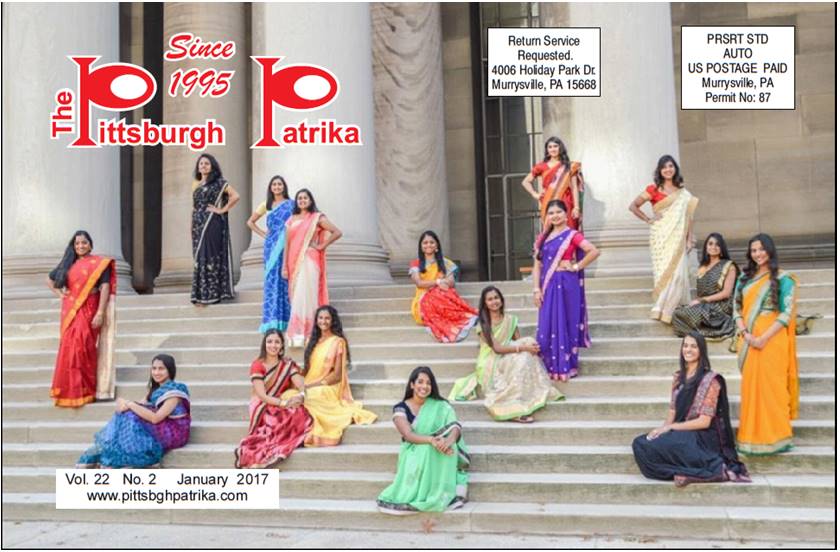
These young women are the University of Pittsburgh’s US-born undergrad students of Indian origin belonging to Nrthyamala, an organization dedicated to Indian classical dance.  Sareena Fayaz, an undergraduate student at the university, took this picture in front of Mellon Institute in Oakland.
One wonders if a bunch of today’s every-day Indian college students in New Delhi, Mumbai, or Bangalore would feel comfortable posing for this kind of pictures wearing saris.  —  By Kollengode S Venkataraman   ♣
“Ab ki bar, Trump Sarkar !” * or “Now onwards, Trump Commands!”
Posted by admin in January 2017 on December 28, 2016
By Kollengode S Venkataraman
On the basis of getting a majority of electoral votes, which is how we elect our presidents, the maverick Donald Trump defeated Hillary Clinton, even though he got 2.5 million fewer popular votes. Trump will be our president for the next four years. We wish him well.
Alt-Right right-wingers filling the airwaves and their supporters nationwide are legitimately gleeful their candidate won. But the traditional GOP establishment and conservative intellectuals are taking a wait-and-see attitude towards Trump’s presidency. They have reason to be cautious. They are on uncharted waters even though they have the White House and the two chambers in the US Congress. Trump is not an ideologue, and is unpredictable. Further, he is a deal maker, a trait he boasted about himself as his strength on the campaign. So, he will be open to compromises on working with Democrats and compliant Republicans in Congress.
More importantly, for his electoral victory he owes nothing to the GOP establishment and Congressional leaders. He was victorious in the elections on his own strength in spite of the GOP establishment’s condescending opposition to him. Politicians have long memories. As a businessman-turned-politician, Trump may neither forgive nor forget his enemies. Thus, the GOP-controlled House and Senate leaders may find the maverick President Trump difficult to work with.
In the meantime, both political parties will dissect what went wrong and try to win back the White House. If Trump is ineffective, it will be easy to take the White House back; but if he delivers even half of what he promised, he would be changing the ground rules of American politics.
End note: The way Trump paraded, as in reality shows, potential nominees for key cabinet positions and the way the nominees obliged him in the charade are indications for President Trump’s style of governing.
For other articles on this presidential election, read here on the perversion of the two-party system, and here on the final stretch of the campaign between Clinton and Trump leading up to the November election.
* During the October Diwali celebrations among Indians in New York, Trump boasted this Hindi expression borrowing from Modi’s Ab ki bar Modi Sarkar.   ♣
On the Hate Crime in South Hills Village Mall
Posted by admin in January 2017 on December 28, 2016
By Kollengode S Venkataraman
e-mail: Â ThePatrika@aol.com
On November 23, in a violent incident that can only be called a hate crime, Ankur Mehta, an Indian-American, was attacked by a 54-year old Caucasian, Jeffrey Allen Burgess. This happened during lunch hour at Red Robin, a restaurant in the South Hills Village Mall. Burgess hurled ethnic slurs against Mehta, mistaking him for a Middle Eastern man of Islamic faith. Unprovoked, he attacked Mehta, elbowing him on the head and punching him. Mehta needed medical attention.
Bethel Park is not in the rural boondocks. It is a bedroom community (95% white population) to Pittsburgh with a median annual household income of $70,000 (for the state it is $55,000), and a population better educated than the state average. An ethnicity-based hate crime in such a bedroom community is bad enough. What makes this scarier is that we have people in urban America today who have not learned to show respect to people of other faiths such as Hinduism, Sikhism, and Islam. Talk about the cultural illiteracy of people in these United States!
One wonders if this hate crime is a random event. This happened in the wake of the poisoned atmosphere in the 2016 presidential campaign. The GOP candidate Trump then, now our President-elect, used provocative languages appealing to working class White voters. They believe they bore the brunt of the economic fallout of globalization with stagnant wages eroding their lifestyle, while professionals and the wealthy made huge gains. This is true. But all working class Americans suffered in this transition, with working class Blacks and Hispanics suffering even more. But Trump succeeded in polarizing voters in terms of ethnicity (mainly against Hispanics) and faith (mainly against Islam). If such hate-crimes can happen in Bethel Park, you can imagine the attitude of less-educated rural Americans toward immigrants.
Before we react defensively about such attacks on Indian-Americans because of the way we look and of our faiths, we need to know the US history towards immigrants. Ever since the nominal ending of slavery in 1863, race relations in the US have always been a work-in-progress. Later, race relations only got complicated. With the arrival of the Irish, Italian, East European, and Jewish immigrants in the 19th and 20th centuries, the mainstream “native†Whites expanded their hatred to these new immigrants. Irish immigrants were not even considered White.  Indians and people belonging to faiths outside the Judeo-Christian religions are the latest ones exposed to this hatred by those among the Whites who are ill informed. Paradoxically, among these haters one would find the assimilated Whites, who, two or three generations ago, were at the receiving end of this ethnic hatred. Sadly, all new immigrants’ attitude—including Indian immigrants’ attitude—towards Blacks is nowhere near what it needs to be.
In this milieu, the good news is that many in the US mainstream are aware of this history. Sheldon Ingram of WTAE reported that a few Indian-Americans and several mainstream activists from the South Hills area were present at the preliminary hearing for Burgess in court, showing support for Ankur Mehta. But many Indian-Americans are unfamiliar with the history of immigration in the US. They may instinctively retract into their shells out of fear or apathy as a defensive, convenient response.
But this is not only immature, but exactly the wrong course of action. While we let the law takes its course and deal with Jeffrey Burgess’ hate crime, we need to set our view on a longer, wider horizon. Wherever we live, we need to frequently interact with people around us in our individual capacities. This takes time and effort. But this is our best bet to integrate ourselves into the American mainstream.
Given our fragmented social groupings here, it is unrealistic to expect our temples or other social groups to take a stand on, or even comment on, hate crimes against individual Indian-Americans like Ankur Mehta. These organizations are traversing in their own orbits far removed from ground realities.   ♣
Red & Blue Counties Paint a Starker Picture
Posted by admin in January 2017 on December 28, 2016
By Kollengode S Venkataraman
e-mail: ThePatrika@aol.com
“Red States†and “Blue States,†and “Battleground States†are now part of our everyday vocabulary. Here is the map for the 2016 results. Just to elucidate the point further, as you can see in the table below, many  states repetitively vote for one party only, irrespective of the merits of individual candidates or their stand on key issues of the time. The two parties take these states for granted either for or against them and move on.
states repetitively vote for one party only, irrespective of the merits of individual candidates or their stand on key issues of the time. The two parties take these states for granted either for or against them and move on.
Voters in only a handful of states carefully weigh the candidates and their stands on the  burning issues of the day and switch back and forth in the quadrennial elections. The outcome of the elections is predicated by how these Battleground States swing. The parties spend lots of their time and resources in these states.
burning issues of the day and switch back and forth in the quadrennial elections. The outcome of the elections is predicated by how these Battleground States swing. The parties spend lots of their time and resources in these states.
If we drill down the idea of the Red and Blue states to counties in each state, we get a stark picture. Here is our own state of Pennsylvania. Pennsylvania is a Red Sea of counties with a few Blue islands here and there. The Blue islands are urban centers with dense population around Pittsburgh, Philadelphia, Harrisburg, Allentown… …
If you take this one step further and look at how the votes split between Clinton and Trump, the picture gets starker. In the picture below, Number 1 is for Allegheny County, with Pittsburgh as its center. The table below shows the details of the vote split between Clinton and  Trump and the population of each county. While Clinton got a respectable 16% spread of votes (56% to 40%) over Trump in Allegheny County, in the surrounding
Trump and the population of each county. While Clinton got a respectable 16% spread of votes (56% to 40%) over Trump in Allegheny County, in the surrounding  counties, Clinton got beaten with spreads varying between 25% and 60%. What saved her from humiliation in a generally Democratic state was the smaller populations in these counties. If you go further into the interior, the margin of loss for Clinton was even sharper, as in Juniata County, where the Clinton-Trump split was17%-79%.
counties, Clinton got beaten with spreads varying between 25% and 60%. What saved her from humiliation in a generally Democratic state was the smaller populations in these counties. If you go further into the interior, the margin of loss for Clinton was even sharper, as in Juniata County, where the Clinton-Trump split was17%-79%.
Even in some of the Blue counties (Center, Monroe and Buck Counties), Clinton won by a wafer-thin margin. The pattern of a Red Sea with islands of Blue counties holds in other states as shown further below for Ohio, Oregon, Illinois and Texas.

Now it is obvious why the country is divided sharply between urban and rural Americans on every measure — age, race, education, income, social values, beliefs… … With this sea of Red counties, Republicans have a big majority among local elected officials across the nation, further adding to this disconnect. So, governing becomes difficult since the rancor never subsides after the elections. We could as well be living in two different countries.
Clinton lost in the Electoral College even after getting 2.5 million more popular votes nation-wide than Trump. If she had reduced the margin of loss in rural counties in Battleground States by reaching out to the rural, less educated, and mostly white voters, she would have won the election.
We can only say this to both political parties on the way they strategize their calculus in national elections: This is no way to run your railroad. If you are addressing the Democrats, you can even add this rhetorical flourish: This is one hell of a way to run your railroad!  ♣
Madhu Aggarwal Recognized for Helping Weirton’s Uninsured and the Needy
Posted by admin in January 2017 on December 28, 2016
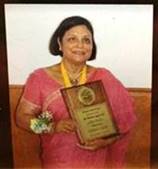 Dr. Madhu Aggarwal, a resident of Weirton, WV for over 30 years, was recognized by the City of Weirton for her work for over twenty years helping the uninsured and the needy in the Weirton area get obstetrics services. She was inducted into the Weirton Hall of Fame in a ceremony in October for Philanthropy.
Dr. Madhu Aggarwal, a resident of Weirton, WV for over 30 years, was recognized by the City of Weirton for her work for over twenty years helping the uninsured and the needy in the Weirton area get obstetrics services. She was inducted into the Weirton Hall of Fame in a ceremony in October for Philanthropy.
In this award, the citizens of Weirton honor those who contribute to improving the world around them. Weirton’s citizens nominate individuals for their work in Business, Industry & Professions, Education & Religion, Music & Fine Arts, Philanthropy, Public Service, and Sports & Athletics. Among the past inductees are educators, athletes, musicians, businessmen, and community volunteers.
Weirton, adjacent to Pittsburgh, was once a buzzing steel-making city, with 13,000 people working in the steel industry at its peak in the 1960s. It had an ethnically diversified, and perhaps segregated, population of nearly 30,000. Today, steel is no more the lifeblood of Weirton. Weirton’s population is 20,000, with steel employing barely around 900 people. Today, the healthcare industry, retail services and steel are the major employers in Weirton, with healthcare and retail services, each employing over 1000 people, more people than steel. Weirton today is a bedroom community for people commuting to work in the Greater Pittsburgh area, including the businesses around the Pittsburgh airport.
Aggarwal founded in the 1980s an obstetrics clinic for the uninsured and underprivileged residents around Weirton, with support from the Weirton Medical Center and its OB staff. She also has helped found a clinic in nearby Steubenville, OH. In 2000, she instituted scholarships for college-bound students in schools around Weirton. She also volunteers at the Jubilee Soup Kitchen in Pittsburgh. The Patrika readers know of her and her husband Krishan’s association with the Hindu-Jain Temple. She was the president there, and is the chairperson of its board of trustees. She chairs a charitable foundation to serve poor patients in remote areas in India, treating thousands of people for free or at a nominal cost.
Madhu was born in Punjab, India. Her father was in the Indian military services and her mother, a teacher. After early schooling in Jammu and Rajasthan, she earned her medical degree from the SMS Medical College in Rajasthan.
She married Krishan, also a physician, in 1976. The young Aggarwals arrived in the US in 1977, with Madhu starting her residency at St. Francis Hospital in Pittsburgh in OB/GYN. They moved to Weirton in 1983, starting their practice. Living in Weirton for over thirty years, they raised their two sons, Neil and Manu. Neil is a clinical psychiatrist at Columbia University, NY, and Manu is the marketing director for an e-Marketing company. Both are married. She loves Bollywood movies and songs, travel, and enjoys reading  whenever she finds time. She and her husband Krishan Aggarwal very recently moved to Moon Township.   — By K S Venkataraman (e-mail:  ThePatrika@aol.com.)   ♣
Obituary:Â Parandham Koduri (1936 to Oct 11, 2016) E-R Physician, Affable and Helpful
Posted by admin in January 2017 on December 28, 2016
 by Bhanu Pandalai and Premlata Venkataraman
Email: Â ThePatrika@aol.com
With sadness, we record the passing away of Dr. Parandham Koduri of Monroeville, PA in the early hours on Tuesday, October 11. He passed away after a brief illness. He was 80.
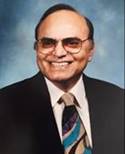 Parandham, as he was known to many, was a friendly and approachable person. He loved being a doctor, and would quickly develop a good rapport with his patients. In 1971, he arrived in Pittsburgh for his residency at the Columbia Hospital, Pittsburgh in Emergency Medicine. After a stint in Minnesota, he came back to East Suburban General Hospital (now Forbes Regional Health) in 1978, as the head of Emergency Medicine.
Parandham, as he was known to many, was a friendly and approachable person. He loved being a doctor, and would quickly develop a good rapport with his patients. In 1971, he arrived in Pittsburgh for his residency at the Columbia Hospital, Pittsburgh in Emergency Medicine. After a stint in Minnesota, he came back to East Suburban General Hospital (now Forbes Regional Health) in 1978, as the head of Emergency Medicine.
He was actively involved as a volunteer at the S. V. Temple, serving in many official capacities. At the Temple he was the President of the Executive Committee and later the Secretary of the Board. Most importantly, he was known as a peacemaker among contentious key members of the temple who did not see eye-to-eye on the temple’s temporal matters. He was also active in the Rotary Club in Monroeville.
Prema recalls his encouraging words to the articles she wrote in this magazine, teasingly telling her to write more than her husÂband. Bhanu too had very poignant memories of his care and support during her husband’s illness.
Parandham was born in Korutla village in Telengana in 1936 and was the first in his family to go to college and then on to medical school. A talented surgeon, the Government of India awarded him a gold medal for his surgical skills. In 1961, he married Tanya, who grew up in Rajamahendravaram (Rajahmundry) in Andhra Pradesh. Parandham had a daughter and two sons.
He was facile in English, Telugu, Hindi and Urdu as well. An eclectic Hyderabadi, he loved Urdu poetry — shayaris, gazals, and nazm. Tanya, his wife, recalls him writing to his father in Urdu!
The funeral services for Parandham were held at the Beinhauer FuÂneral Home on West Liberty Avenue with a large number of Parandham’s friends and relatives sharing their grief with the Koduri family. Sunil and Venugopal, Parandham’s sons, performed the Vedic Hindu cremation rites with help from Shri Venkatacharyulu and Shri Varadarajan, the priests from the S.V.Temple.
Parandham leaves behind his beloved wife Tanya; daughter Sailaja and family of Pittsburgh PA; first son Venugopal and family of Suffolk, VA; second son Sunil and family of Seattle, WA; and his grandchildren — Vishal, ShiÂvani, Natasha, Rohan, Maya and Hans Raj. He also leaves behind a large number of friends in the Pittsburgh metro area.  ♣
Britannia, You’ve Come a Long Way, Baby!
Posted by admin in January 2017 on December 28, 2016
By Kollengode S Venkataraman
e-mail: Â ThePatrika@aol.com
British Prime Minister Theresa May was in India in November to strengthen the British economy, months after the Brexit referendum voted for leaving the EU. She was seeking the support of Britain’s erstwhile “Jewel in the Crown†to bolster trade in the era of emerging India and the not so-great Britain.
In today’s world, one sure way to court India is to court Indians living among you. So, May hosted a Deepavali function at 10 Downing Street, days before her official visit to India. She lit a traditional lamp and said, “The festival played an important part in our national life. When we analyze the true meaning of Diwali, its relevance extends beyond India, beyond the Indian diaspora and even beyond the Hindus, Jains, Sikhs and Buddhists who, in different ways, mark the festival. Its messages apply to every single one of us – whatever our background, whatever our faith.â€
She continued, “I haven’t read all 24,000 verses in the epic about Lord Rama’s return to Ayodhya. But I do know the story of his homecoming from the many Diwali celebrations I have attended in my own constituency over the years. The values he [Rama] embodied are values which we can all heed. Values of charity, sacrifice and responsibility; to paraphrase Mahatma Gandhi: losing ourselves in the service of others.â€
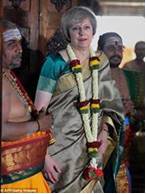 She surprised everyone again during her visit to India in November when she visited a Shiva Temple in Bengaluru, dignifiedly wrapped in a traditional silk sari (see the picture), even partaking in the arati at the temple.
She surprised everyone again during her visit to India in November when she visited a Shiva Temple in Bengaluru, dignifiedly wrapped in a traditional silk sari (see the picture), even partaking in the arati at the temple.
Quite a transformation for a British prime minister, one of whose predecessors, Winston Churchill, in 1931, before he became the prime minister, refused to meet with Gandhi who was in London, referring to Gandhi as “half-naked†and a “seditious fakirâ€!
For many Indians, this transformation is bittersweet. After all, the British came to India as traders. Taking advantage of the weak and fragmented polity, the traders ended up ruling over the entire subcontinent for over 150 years. Finally, even after winning World War II in 1944, the empire collapsed, The British hurriedly left India in 1947, leaving the Indian subcontinent in a mess, the effects of which are seen even today.
All through the British occupation, even though individual British archeologists, historians and linguists took interest in India, the English Establishment — British bureaucrats, army officers and even lowly clerks — with their stiff upper lips, barely tolerated the “native†Indians. The desi Brown sahebs took their cue from their Goras, becoming even more insufferable in dealing with the “natives.â€
But years later, beginning in the1960s, Indian engineers, scientists and doctors migrated to the US and Canada and made their imprints in universities,  corporate R&Ds, hospitals, and as entrepreneurs. This greatly enhanced India’s image globally. In the UK itself, Indians account for over 20% of the doctors in its healthcare system. The large number of Gujaratis from Africa who landed in the UK as refugees became entrepreneurs running successful businesses.
corporate R&Ds, hospitals, and as entrepreneurs. This greatly enhanced India’s image globally. In the UK itself, Indians account for over 20% of the doctors in its healthcare system. The large number of Gujaratis from Africa who landed in the UK as refugees became entrepreneurs running successful businesses.
Ater India liberated itself again in the 1980s from the clutches of the Nehruvian socialist ideology, India’s innate entrepreneurial instincts resurged. Today, with much of the industrialized economies of the world (North America, Western Europe, and Japan) dormant, and China slowing down, India has an impressive 7% growth rate. With Britain caught in its own vice in the Brexit referendum and the threat of its weakening links in the EU, it is looking for new business opportunities in India, but this time, probably on India’s terms. No wonder Britain comes calling once again, this time doing it with charm, in contrast to Colonial days’ disdain, condescension and guns! India is pragmatic. With its mercantile instincts, India is ready to work with its past ruler, but on its own terms.
And Theresa May made every right gesture to appeal to Indians. She looks trendy and fashionable in the contemporary sari, and carried herself with great élan and dignity in a traditional silk sari in Shiva temple in Bengaluru.
So, without appearing to be offensive to Prime Minister May, I am gleeful to declare, “Britannia, You’ve come a long way, baby!†  ♣
Sowmya Srinivasan’s Delightful Veena Arangetram
Posted by admin in January 2017 on December 28, 2016
By Shriram MurthyÂ
e-mail: dr.shriram.s@gmail.com
On June 26th, 2016, Sowmya Srinivasan, a student of Latha Sekaran, had her veena Arangetram recital at the 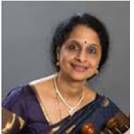 S.V.Temple auditorium in the presence of music connoisseurs, friends and families. Sowmya has been learning Veena from Latha Sekaran (picture on the left)) for the last six years. Her grandmother Smt. Rajalakshmi Gopalan, who plays and teaches veena in Chennai is Sowmya’s inspiration. Sowmya has also performed at the Cleveland Tyagaraja Aradhana under the guidance of Guru Neyveli Santhanagopalan.]
S.V.Temple auditorium in the presence of music connoisseurs, friends and families. Sowmya has been learning Veena from Latha Sekaran (picture on the left)) for the last six years. Her grandmother Smt. Rajalakshmi Gopalan, who plays and teaches veena in Chennai is Sowmya’s inspiration. Sowmya has also performed at the Cleveland Tyagaraja Aradhana under the guidance of Guru Neyveli Santhanagopalan.]
Senior percussion artistes, veterans Ravi Balasubramanian on the ghatam and Sriram Ramanan on the mrdangam accompanied Sowmya providing enthusiastic and encouraging support to the young veena player, which further enlivened her first solo recital.
The Arangetram started with the Navaragamalika Varnam, followed by Muthuswami Dikshithar’s Shri Saraswati Namostute.  In the next piece in raga Panthuvarali, Swati Tirunal’s Sarasaksha paripalaya maam, Sowmya delightfully brought out the Bhakti bhava (mood of devotion).
 The main piece of the evening was Tyagaraja’s popular work Chakkani raja, in the raga Karaharapriya, a sampoorna raga, the 22nd Melakarta raga, with all seven notes in both the arohanam and avarohanam.  The challenging phrases with swaraprasthanams were very beautifully rendered with able variations. The tani avartanam by the veteran percussionists was quite arresting. Sowmya then rendered a Tiruppugazh verse of the 16th century ascetic Arunagirinaadar followed by Swamy Dayananda’s Bho Sambho, a popular number performed by numerous artists. It was mesmerizing to listen to this piece on the veena.
The main piece of the evening was Tyagaraja’s popular work Chakkani raja, in the raga Karaharapriya, a sampoorna raga, the 22nd Melakarta raga, with all seven notes in both the arohanam and avarohanam.  The challenging phrases with swaraprasthanams were very beautifully rendered with able variations. The tani avartanam by the veteran percussionists was quite arresting. Sowmya then rendered a Tiruppugazh verse of the 16th century ascetic Arunagirinaadar followed by Swamy Dayananda’s Bho Sambho, a popular number performed by numerous artists. It was mesmerizing to listen to this piece on the veena.
Next, Sowmya rendered a tillana and the famous Western-sounding notes without any lyrics, inspired by Irish/Scottish melodies, popularized by Madurai Mani Iyer in the mid-20th century. Sowmya wrapped her evening recital with a Hari Bhajan in Tilang and a traditional Mangalam.
It is rare among youngsters growing up in America or even in India to learn to play on the veena and reach a level of giving solo recital. So, Sowmya’s dedication towards this pursuit is noteworthy. Sowmya, her guru Latha Sekaran and her parents would be pleased that all their collective efforts paid off well. We wish Sowmya well to reach greater heights in her musical journey in the years to come.   ♣
India’s Consul General Visits Pitt
Posted by admin in January 2017 on December 28, 2016
By Premlata Venkataraman
e-mail: Â ThePatrika@aol.com
The University of Pittsburgh’s Center of International Studies hosted a reception for Riva Ganguly Das, India’s Consul General at New York on Thursday, November 10 at the Barco Law Building. The faculty, uniÂversity officials and invited members of the Indian community attended the reception.
Consul GenÂeral Ganguly Das has served in many countries before her assignment in New York. In her general remarks, she said, in her postings to many countries she always was impressed by the vibrancy of people of Indian origin living there, and how well they socially and culturally have adapted themselves to their new environments even as they retained their cultural identity. In this respect, Pittsburgh’s Indian-American community is a fine example, she said. India considers the people of Indian origin living outside India as a big asset in strengthening its bilateral relationship in these countries.
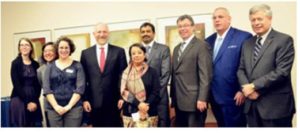
L to R: Rachel Jacobson, Lynn Kawaratani, Emily Rook-Koepsel , Ariel Armony, Consul General Riva Ganguly Das, Consul Trade Sreenivasa Rao Gudavalli, James Cook, Ira Gumberg at Pitt’s Asian Studies Center, and Chancellor Emeritus Mark Nordenberg.
She also pointed out that India is trying to learn from the dynamic and interdisciplinary academic environment in leading US academic institutions such as Pitt, and adapt it in top-of-the-line Indian academic institutions.
Earlier, Prof. Ariel Armony, the director of the university’s InternaÂtional Programs, highlighted the number of international students from India at Pitt. He also described the features of the South Asia Initiative, Pitt’s 3-year program focusing on the region in which India is front and center, geographically, culturally and technologically as well. India’s recent economic growth is an added new dimension. For the 2016-17 academic year, one interesting topic is India and Pakistan at 70: AspiraÂtions and Speculations. See the details here: www.ucis.pitt.edu/asc/events/southasia.
Mark Nordenberg, the Chancellor Emeritus of the University, in introducing the consular official, recalled India’s long tradition of learnÂing, teaching and transmitting knowledge accumulated from generation to generation spanning over four millennia. He acknowledged India’s comÂmitment to nonviolence, tracing it from the Mauryan emperor Ashoka, who lived 300 years before the Common Era to Mahatma Gandhi’s comÂmitment to civil disobedience and ahimsa.
Prof. James Cook, the acting director of the Asian Studies CenÂter, effortlessly emÂceed the events of the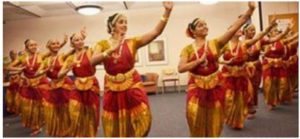 evening, starting with Bharatanatyam pieces by Pitt’s Nrityamala, a group of mostly Indian-American undergraduÂate students.
evening, starting with Bharatanatyam pieces by Pitt’s Nrityamala, a group of mostly Indian-American undergraduÂate students.
In responding to a question in the wake of the unexpected outcome of the US presidential elections, she said the US and India are mature democracies, with elections leading to a very peaceful transfer of power. She said, “The US-India bilateral relations can only go from strength to more strength because of the convergence of interests.â€
Note: The University of Pittsburgh offers Hindi courses. For details, contact Dr. Sugandha Verma at 724-934-4376.    ♣
Balamuralikrishna: A Rare Artiste Who Honored Arts Patrons and Other Artistes
Posted by admin in January 2017 on December 28, 2016
By Dr. Balwant Dixit (bdixit@pitt.edu) and Dr. P. Sundararaman (psundararaman@hotmail.com)
Editor’s Note: Kings and temples in South India have been patrons of artists for over 2500 years. Maharajas, nawabs, kings throughout the world have supported artists to showcase the grandeur of their kingdoms. In the last 100 years, with the kingdoms gone, elected governments have filled the void. The government of India in the 1950s founded the Indian Council of Cultural Relations and the Sangeet Natak Academi to promote arts and artistes. Indian music organizations routinely confer titles on musicians. While artistes vie with each other and lobby for these honors — scientists too are known to lobby for even Nobel Prizes — it is very rare to see artistes honoring other artistes and even patrons. One such artiste was Balamuralikrishna, the renowned Indian vocalist, who died in November 2016.  He was in his 80s.
H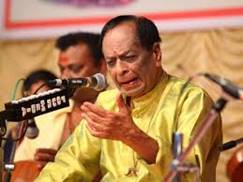 ere is the experience of Dr. Balwant Dixit, in his own words, on his receiving the honorific Kala Vipanchee from Balamuralikrishna in 1999. Vipanchi is the name of a type of lute, and also is a descriptive Sanskrit word for a person who loves and advances the causes of arts and music. Dr. Dixit for over forty years worked against many odds bringing artists from all over India on concert tours in North America. It is important to note that Dr. Dixit did NOT sponsor concert tours for Balamuralikrishna; the artist was not seeking a favor from, or returning a favor to, Dixit. Here goes Dr. Dixit:Â
ere is the experience of Dr. Balwant Dixit, in his own words, on his receiving the honorific Kala Vipanchee from Balamuralikrishna in 1999. Vipanchi is the name of a type of lute, and also is a descriptive Sanskrit word for a person who loves and advances the causes of arts and music. Dr. Dixit for over forty years worked against many odds bringing artists from all over India on concert tours in North America. It is important to note that Dr. Dixit did NOT sponsor concert tours for Balamuralikrishna; the artist was not seeking a favor from, or returning a favor to, Dixit. Here goes Dr. Dixit:Â
On November 13, 1999 I received a letter of invitation from Padmavibhushan Dr. Balamuralikrishna to attend a special ceremony to receive the title Kala Vipanchee at a special function to be held at the Madras Music Academy for my efforts in promoting Indian classical music in North America. It was somewhat of a surprise.
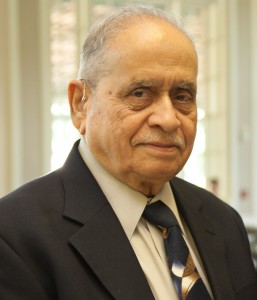 I flew to Chennai from Pittsburgh via Pune. At the Chennai airport, a representative from the Balamuralikrishna Trust warmly received me and two young women put flower garlands around my neck. I was driven to the New Woodland Hotel. I checked into a small bungalow located on the premises of the hotel. Soon, a welcoming phone call came from Dr. Balamuralikrishna himself enquiring me about my travel. He informed me about the next day’s function. A hotel attendant brought me tea and snacks. In the evening I was served a complete dinner in my room.
I flew to Chennai from Pittsburgh via Pune. At the Chennai airport, a representative from the Balamuralikrishna Trust warmly received me and two young women put flower garlands around my neck. I was driven to the New Woodland Hotel. I checked into a small bungalow located on the premises of the hotel. Soon, a welcoming phone call came from Dr. Balamuralikrishna himself enquiring me about my travel. He informed me about the next day’s function. A hotel attendant brought me tea and snacks. In the evening I was served a complete dinner in my room.
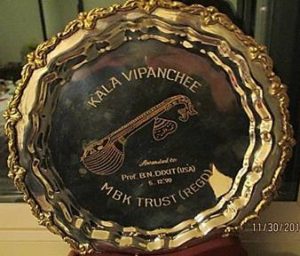 Next day, another representative from the Trust drove me to the Madras Music Academy for the awards ceremony. The auditorium was packed with over one thousand people for the occasion. The ceremony started with an invocation. The Nrityalaya Aesthetics Society from Singapore presented Parinamam, a dance drama based on Ramayana. There were also a couple of music performances. This was followed by the awards ceremony recognizing individuals and organizations for promotion of the performing arts. Then Dr. Balamuralikrishna himself presented me the title Kala Vipanchee.
Next day, another representative from the Trust drove me to the Madras Music Academy for the awards ceremony. The auditorium was packed with over one thousand people for the occasion. The ceremony started with an invocation. The Nrityalaya Aesthetics Society from Singapore presented Parinamam, a dance drama based on Ramayana. There were also a couple of music performances. This was followed by the awards ceremony recognizing individuals and organizations for promotion of the performing arts. Then Dr. Balamuralikrishna himself presented me the title Kala Vipanchee.
I was told that the other recipients of the Kala Vipanchee honorific are Ustad Zakir Hussain; the veteran Ghatam vidwan “Vikku†Vinayakram; and Pandit Vijay Kichlu of the Sangeet Research Academy of Kolkata. At the end Dr. Balamuralikrishna himself gave a scintillating vocal recital.
The function concluded with a dinner served behind the stage in which Dr. Balamuralikishna, Vikku Vinayakram and several other distinguished artistes and individuals ate a typical South Indian dinner on paper plates. It was quite an interesting gathering where all those who gathered — many of them veteran artistes — were having dinner on paper plates without any reservations.     —  By Balwant Dixit
Dr. P. Sundararaman from Allison Park adds:
“Balamuralikrishna was a multi-faceted genius who challenged the orthodoxy of Karnatic music in his time. Finding himself in controversies on account of his fresh interpretation of music, he relished seeing the ‘traditionalists’ eventually admiring and acknowledging his genius…”
This is how I summed up his genius on the early rainy morning in November, when I heard the maestro had died. I opened one of my favorite live concerts of him on my PC, hoping to calm myself. It did help.
I was exposed to Karnatic music from my childhood in the 1940s. I started listening to Balamurali’s concerts a decade later. With his stunningly novel, fresh and appealing renderings, he took the Karnatic music world by storm. I am fortunate to have known him personally as an admirer, friend and student. His mind was youthful, and his enthusiasm, infectious.
His mother was a veena player and his father, a violinist. Losing his mother when he was very young, he was raised by his mother’s elder sister. His formal schooling was only for three months. On his own, he learned many languages, including Sanskrit — even composing lyrics in them.
In 1976 I came to North America. In the annual Tyagaraja festivals, I sang the krtis I learned from Balamurali’s cassette tapes I brought with me. Later, when he was here on concert tours, I attended many of his concerts, sometimes sharing car rides with him. After a concert at Penn State in the 1990s, Balamurali and eleven members of his troupe came to our home late on a Friday night. Next day we drove them to Niagara Falls and to his recital in Buffalo, NY. In his 4-hour concert, he mathematically demonstrated his new tala concept encompassing most of the talas.
In the 1990s, the maestro released a recording of the 17th century (?) Advaita mendicant Sadasiva Brahmendra’s verses set in Karnatic ragas. These renderings were on repeat loop in our car and at home.
He was so confident about his prowess that he engaged in jugalbandis with stalwarts such as Bhisen Joshi, Ronu Majumdar, Pandit Jasraj and many others. These are on YouTube.
During one of our visits to his home in Chennai, he insisted, “You have driven us to many places in the US. Now it is my turn to drive you to Thyagabrahma Sabha.†With the maestro, we visited a temple, where we all had breakfast served on banana leaf, squatting on the floor! Hats off to his child-like simplicity!
In 2005, I went to see him in Chennai. He taught me several of his compositions. Despite his age and stardom, he was always a teacher, with the same spirited smile and friendliness. In his later years, to encourage youngsters, he regularly appeared in the front row at music competitions for teenagers organized by TV stations.
I will forever cherish these and many other memories, and the invaluable gift he gave me: an autographed book of all his compositions  ♣
Fortune Hunting in Far-off Lands is not New
Posted by admin in January 2017 on December 28, 2016
By Kollengode S Venkataraman
e-mail: Â thePatrika@aol.com
The boom of the petrodollars saw working-class people from many parts of Asia go to the Arabian Peninsula seeking high-paying jobs under horrible living conditions. The lure of money forced men to be away from their wives and family for the greater part of the year, giving rise to many social problems. Later, globalization made this a worldwide trend.
A 2000-year old Tamil literary work tells us that men going to far-off lands searching for fortunes is not a new phenomenon. Here is a verse from Kalittogai by the poet Perum-kadum-Ko. (Source: Kalittogai Telivurai by Puliyur Kesigan, Pari Nilayam, Chennai, 2005). The confidante of a married woman tries to dissuade her husband contemplating a voyage seeking fortunes, like men today leaving their wives to “go abroadâ€:
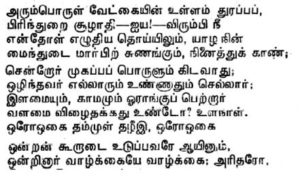
Gist of the message: “Sir, Don’t live with thoughts of living away from your woman for earning fortunes in far-off lands. See the imprints you two have caused to each other while in tight embrace. The fortunes you think you’re going to amass are not going to stay with you. Also know that men who do not go on this type of fortune hunting are not starving either.
“Couples with youth and passion for each other — do they ever care for material things to make them happy? Besides, does wealth have any redeeming quality better than youth and passion for people in love?
“When couples have youth and passion for each other, they would rather live in each other’s embrace, even if they live with scarce resources, with only simple garments to wrap themselves with. Living with each other thus is what happiness is for couples in love.
“With fortunes earned thus, is it ever possible to regain the youth that will be gone when you’re away?â€
We don’t know if the young man stayed home with his beloved. Probably not. After all, most readers of this article did not heed similar advice from their parents, if not from the confidantes of their beloved.
— By Kollengode S VenkataramanÂ
Kalaa Arpan:  Babeena Sharma’s Pleasant Recital
Posted by admin in January 2017 on December 28, 2016
By Jayashri Phanse
e-mail: jsphanse560@hotmail.com
On Saturday, September 10, under the auspices of the S.V.Temple, Babeena Sharma offered Kalaa Arpan, a semi classical Hindustani vocal recital. It was indeed a refreshing change for the Temple’s audience used to only South Indian classical art forms in recent times.

Babeena, after the customary Ganesh Vandana, chose Kasturi tilakam lalata patale… in Madhuvanti, a verse from Naaraayaneeyam, a 16th century work by Narayana Bhattathri of Kerala, to begin the concert. The verse describing Krishna’s ever-beautiful form, took the audience along to visualize the adoration of Gopis for Krishna with all his adornments. This was followed by Ullanghe Sindho in the raag Bhatiyar dedicated to Hanuman, who, in Ramayana, crossed the hundred yojanas of the ocean to find Sita in Lanka.
A disciple of Pandita Tripti Mukherji, Babeena shared an amusing anecdote tracing the origin of the verse in Mukherji’s interactions with Pandit Jasrajji, the Bade Guruji for all the disciples of Guru Mukherji. Babeena mellifluously traversed through the raga to give the audience a meditative experience of a bairagi.
After doing adequate justice to the Great Miya Tansen’s composition Teri Gati in raag Malkauns, Babeena presented another challenging masterpiece, Mata Kalika in raag Adana, describing Kali as the Supreme Mother. In the next piece, Dwadasha Jyotirlinga in raag Mangal Bhairava, Babeena musically described Shiva, the other half of the Ardhanareeshwara form.
With Venky Sharma, Babeena’s husband as the Master of Ceremony and their children Ashutosh and Kamakshi on vocal support, this piece and the following became a nice family presentation.
The next two were devotionals on Krishna. The first, Laal Gopal – a Haveli Sangeet –from Western India, depicted the colorful Holi festival. The second was a popular Purandara Dasa Devaranama – Jagadodhdharana in the Raag Kapi. In her lilting voice Babeena successfully painted the picture of mother Yashoda blissfully playing, sometimes remonstrating little Krishna, all this in total oblivion of the fact that she has the Supreme Lord in her arms. Babeena choosing the popular number and rendering it in the Karnatic style was well appreciated by her audience.
Asatoma sat gamaya, which was next, was Babeena’s dedication to her mother and first Guru, Behroze Chatterji, whom she considers an eternal source of inspiration. In the concluding piece, Om Namo Bhagavate Vasudevaya in raag Bhimpalasi, the artist invited the audience to join in the devotional chant maintaining. All through the evening, Babeena was confident, and came across as dedicated while she created a spiritual meditative mood.
Aqeel Bhatti on the Tabla provided percussion support while Arif Mani accompanied the artiste on the harmonium.   ♣
The Blue Sweater in My Drawer
Posted by admin in January 2017 on December 28, 2016
Samar Sinharoy, Monroeville, PA
e-mail: Â samar.sinharoy@gmail.com
Note:  Samar spent most of his working life as a research scientist at the now-defunct Westinghouse Science and Technology Center in Churchill. Post-retirement, he taught physics for five years at Robert Morris University. He spends his time socializing at the gym, reading, visiting his kids and grandkids, traveling, and taking Osher learning program courses at Pitt.
 There is a blue sleeveless sweater in my dresser drawer. I have had it for over half a century. It has a beautiful design; but with the color faded, the wool looks frazzled. I don’t use it anymore. Nevertheless, occasionally I take it out, just to look at it fondly remembering the person — my ma — who knitted it, and simply put it back.
There is a blue sleeveless sweater in my dresser drawer. I have had it for over half a century. It has a beautiful design; but with the color faded, the wool looks frazzled. I don’t use it anymore. Nevertheless, occasionally I take it out, just to look at it fondly remembering the person — my ma — who knitted it, and simply put it back.
I  grew up in Puri, a coastal city on the Bay of Bengal in Odisha, India. It never got too cold there, so all we needed in winter was either a thin shawl or a sleeveless sweater. We were five siblings in our house. The sixth one was already out of the house — in Kolkata.
Although my father was the breadwinner, my mother was the glue for the family. She did all the cooking using a coal-burning stove that had to be fired up each morning. With no refrigerator, fresh food had to be cooked every day. She worked hard all day. Yet she never complained, and was always pleasant. She was an avid reader and inspired us to read. She loved music, played on the harmonium, and taught my two sisters vocal music.
She also spent a considerable amount of time sewing and knitting. I was in the second year of college in 1958, when she knitted this particular blue sweater for me. I loved it, wearing it all winter long.
I brought the sweater with me when I came to the U.S. in 1966 to go to graduate school in New York City. After my PhD, did a post-doctoral stint in Germany, and came back in 1975 for a second post-doc assignment at the University of Missouri-Rolla. That is where I met my wife Semahat, a lovely young woman from Turkey, who had arrived the previous year at Rolla for her MS in Metallurgy. We got married in 1976 and moved to Pittsburgh in 1978, where both of us started working for Westinghouse. Like many other immigrant Indians, we bought a house in the suburbs, two cars, and had a daughter and a son. Through these transitions, I kept using my blue sweater.
Now retired, time is catching up on me. The kids live far away in Atlanta, not as far away as I was from my parents. My wife of nearly forty years of marriage passed away in her sleep a few years ago.
Thinking about her, I realize that she had some of the same qualities that made my mother so special. Maybe subconsciously, I was looking for a person with those qualities: my wife was a great cook, an avid reader, and a knitter to boot, among many other things. She knitted a green, long-sleeve turtleneck sweater for me, which I treasure.
My blue sweater is too old to wear any more, but I am still saving it as a reminder of a time gone by, of a less complicated era.
We as parents hand over to our kids things from our era, like the blue sweater I received from my ma. I wonder, a few decades from now, will my kids too, in their retirement, brood over the knick knacks we give them, as I do now.  ♣
Sunflower: A Short Film on Aging & Memories
Posted by admin in January 2017 on December 28, 2016
By Premlata Venkataraman
e-mail: Â ThePatrika@aol.com
The day after Black Friday saw the Pittsburgh screening of Sunflower, a 15-minute short film with our own Juginder Luthra debuting in films in his semi-retirement. The film, directed by 23-year old Peter Ferris Rosati, was screened at the Row House Theater in Lawrenceville.
 A sensitive film about the elderly selectively nurturing their memories — and haunted by them — is the theme of this short film. The sunflower with its many pods is an allegory for the elderly selectively recalling events retained in their memories. Each pod is a sachet of memory retained.
A sensitive film about the elderly selectively nurturing their memories — and haunted by them — is the theme of this short film. The sunflower with its many pods is an allegory for the elderly selectively recalling events retained in their memories. Each pod is a sachet of memory retained.
The only character in the film, a 70-plus year old man, is living all by himself in a dingy and grimy apartment; he remains nameless and utters not a single word of dialog.
He cherishes the sunflower plant in his backyard he has carefully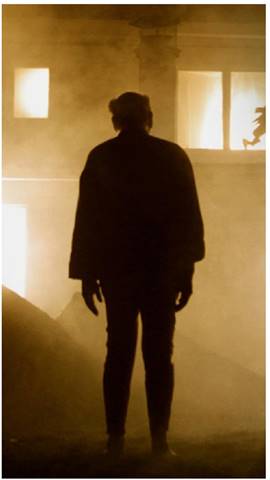 kept alive, the same way he cherishes his memories. But the ravages of time, allegorically portrayed by a large made-up bird that looks like a raven, repeatedly seeks to destroy the flower — eventually succeeding in doing so — in spite of the best efforts of the elderly man to keep it alive. How it affects the old man is the grand finale.
kept alive, the same way he cherishes his memories. But the ravages of time, allegorically portrayed by a large made-up bird that looks like a raven, repeatedly seeks to destroy the flower — eventually succeeding in doing so — in spite of the best efforts of the elderly man to keep it alive. How it affects the old man is the grand finale.
Luthra, without the benefit of spoken words, brings out the intense anguish of the character waging a losing battle against time. He portrays anger, fear, self-pity, and helplessness as he tends to the plant, with occasional flashbacks of memories haunting him.
Talking to me after the screening, Â Luthra told me, the 15-min film was chiseled out of nearly seven hours of videotape footage.
The young director Peter Ferris Rosati — he is still in his early 20s — shows maturity in sensitively bringing out from Luthra’s nameless character how the elderly hold on to their memories, when life around them already has fallen apart.   ♣
. Ha !
Posted by admin in January 2017 on December 28, 2016
By K S Venkataraman
e-mail: Â thepatrika@aol.com
In India, from time immemorial rivers have been used as a metaphor for life’s challenges. Hina-yaanam (literally, the Small Vehicle or Boat) and Maha Yaanam (Big Vehicle or Boat) are Buddhism’s two branches. The Yaanam is for crossing the river of Duhkham (discontentment in life). Samsara sarovar (the sea of life) is the expression used again and again in Dharma-based literature. Teerthankaras (literally, Boatmen Who Help to Cross the River) are great teachers in the Jain tradition helping people to cross the river of life.
River as a metaphor for life in India is entirely understandable since rivers, big-and-small, are everywhere that people need to cross — the mighty Brahmaputra, Sindhu, and Ganga, the erratic Kosi; and the Narmada, Tapti, Mahanadi, Godavari and Krishna, Kaveri, Kaaladi…
So, it is not surprising that the Urdu poets too have used rivers and boats as metaphors in their poetry. Here is a doha (couplet) by Akhbar Allahabadi (1846-1921), sent to us by Harish Saluja, the painter, music lover, film producer/director… :

The difference between old and new ‘light’ (wisdom) is this:
 One can’t find the boat, and the other can’t find the shore.
The “old†and the “new†can be interpreted generationally as the old people and young people in every era; or as Old Wisdom and New Wisdom in the chronological sense.
River-and-boat based themes and motifs have continued to fascinate Indians as we see in popular songs with great lyrics, tuned to melodious folk-tunes and beautifully picturized in films. Here are examples you can access on YouTube:
Asaiyé alaipolé (Tamil):  www.youtube.com/watch?v=ydi-WAnlXfE
Odam nadiyinilé (Tamil):  www.youtube.com/watch?v=Mq3DDO7gNYg
Kari mukhil kaattilé (Malayalam):  www.youtube.com/watch?v=rIfv-KpmN7I
O ré maaji mera saajan he us par:  www.youtube.com/watch?v=5OVFQVNlU1U
O maaji ré (Hindi):  www.youtube.com/watch?v=iD6UvXVyfpI
Majhi baiya jau re (Bengali): Â www.youtube.com/watch?v=-5U9dUpM3vA
In Asaiye Alaipole a boatman is shown ferrying people across a river, singing in a typical folksy tune about people getting tossed hither and tither in the waves of the river, an apt metaphor for a life full of desires and their pursuits.   ♣
